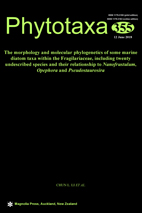Abstract
Dozens of monoclonal cultures of small-celled araphid diatoms from brackish or marine habitats worldwide were analyzed using morphological observations (light and electron microscopy) and molecular data (nuclear-encoded small subunit ribosomal RNA and chloroplast encoded rbcL and psbC). As a result, we established one new genus Gedaniella, distinguished by a shared morphological character (occlusions of branched volae, projecting from the apical sides of the areolae) and some molecular data, including five new species: G. alfred-wegeneri, G. arenaria, G. boltonii, G. panicellus, G. paucistriata and three new combinations: G. flavovirens, G. guenter-grassii and G. mutabilis. Additionally we describe eleven novel species within the existing genus Serratifera: S. andersonii, S. brevis, S. clavata, S. corallina, S. namibica, S. nosybeana, S. parkii, S. punctata, S. rhombica, S. sourniae, S. takanoi and one new combination S. opephoroides. Furthermore, five new taxa or combinations were described within other genera: such as Cratericulifera crinigera, Nanofrustulum wachnickianum, Plagiostriata baltica, Pseudostaurosira madagascariensis and Stauroforma rinceana. Detailed descriptions for established species are also provided: Nanofrustulum shiloi, Opephora pacifica and Pseudostaurosira elliptica. This study strongly suggests that the complete biodiversity of small-celled araphids is still far from known, and many species currently placed in Opephora and Pseudostaurosira need to be further re-investigated.

